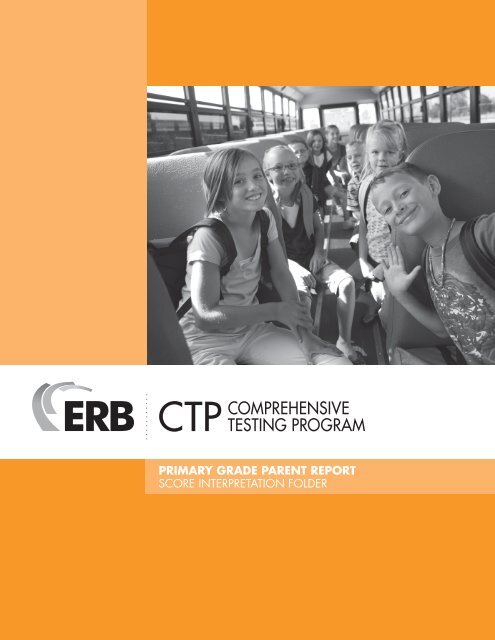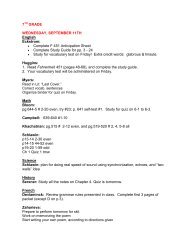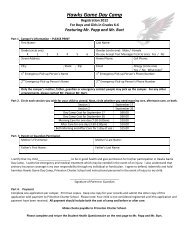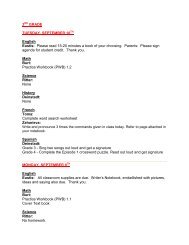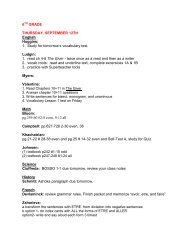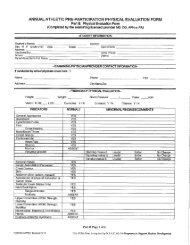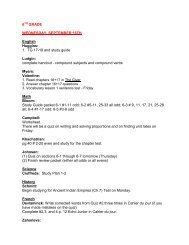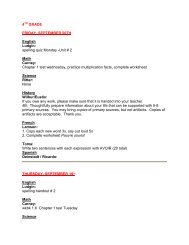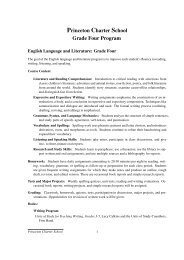PRIMARY GRADE PARENT REPORT SCORE INTERPRETATION ...
PRIMARY GRADE PARENT REPORT SCORE INTERPRETATION ...
PRIMARY GRADE PARENT REPORT SCORE INTERPRETATION ...
Create successful ePaper yourself
Turn your PDF publications into a flip-book with our unique Google optimized e-Paper software.
<strong>PRIMARY</strong> <strong>GRADE</strong> <strong>PARENT</strong> <strong>REPORT</strong><br />
sCore interpretation Folder
What does this<br />
report tell you?<br />
The Primary Grade Parent Report<br />
describes your child’s performance<br />
on the CTP Online tests. The report<br />
contains a section for each test that your<br />
child took.<br />
The questions on each test are classified<br />
into content areas. The tests and content<br />
areas are described below. In each<br />
content area, your child’s performance<br />
on the test is classified as: exceeding<br />
expectations, meeting expectations,<br />
or developing. The report shows your<br />
child’s Student Percent Mastery of<br />
Content score in each content area.<br />
What is a Student Percent Mastery of<br />
Content score? It looks like a percent<br />
correct score but it is not. Based on<br />
a student’s performance and the<br />
characteristics of the items answered<br />
correctly, it is an estimate of the<br />
percentage of items a student would<br />
get correct if he or she could take all<br />
items in a particular content area.<br />
Student Percent Mastery of Content<br />
scores have a higher degree of reliability<br />
compared to percent correct scores<br />
because the Student Percent Mastery<br />
of Content scores are based on both the<br />
characteristics of the items answered<br />
correctly and the student’s performance<br />
level.<br />
The Student Percent Mastery of Content<br />
score required to meet expectations and<br />
to exceed expectations in each content<br />
area is based on the judgments of a panel<br />
of first- and second-grade teachers at<br />
schools using CTP tests.<br />
What are Lexile ® and<br />
Quantile ® measures?<br />
You may see reported Lexile and<br />
Quantile measures on your child’s<br />
report. A Lexile measure represents your<br />
child’s reading ability and can be used to<br />
match him or her with books and other<br />
materials at an appropriate difficulty<br />
level. A Quantile measure describes your<br />
child’s mathematical ability and can be<br />
used to determine his or her readiness<br />
to learn new mathematical skills and<br />
concepts. Please visit erblearn.org/ctp<br />
for more information.<br />
tEST AND CONTENT<br />
AREA DESCRIPTIONS<br />
Auditory Comprehension<br />
This test measures students’ ability to<br />
understand and interpret information<br />
presented orally. The content areas<br />
included in the Auditory Comprehension<br />
test are:<br />
• Vocabulary in Context: Using context<br />
clues to determine the meaning of a<br />
word or phrase in a text read aloud<br />
• Explicit Information: Identifying<br />
explicit details from a passage read<br />
aloud and providing answers to<br />
“who,” “what,” “where,” “when,”<br />
“why,” and “how” questions about<br />
the text<br />
• Inference: Using implicit information<br />
from a passage read aloud to make<br />
inferences about the motives or<br />
behaviors of characters and to<br />
summarize and draw conclusions<br />
about the text<br />
• Analysis: Drawing connections<br />
among various pieces of information<br />
in a text read aloud and synthesizing<br />
information to make predictions or<br />
draw conclusions about the text<br />
Reading Comprehension<br />
This test measures students’ ability<br />
to understand and interpret written<br />
text. The content areas included in the<br />
Reading Comprehension test are:<br />
• Vocabulary in Context: Using context<br />
clues to determine the meaning of a<br />
word or phrase in a text<br />
• Explicit Information: Identifying<br />
explicit details from a passage and<br />
providing answers to “who,” “what,”<br />
“where,” “when,” “why,” and “how”<br />
questions about the text<br />
• Inference: Using implicit information<br />
from a passage to make inferences<br />
about the motives or behaviors of<br />
characters and to summarize and<br />
draw conclusions about the text<br />
• Analysis: Drawing connections<br />
among various pieces of information<br />
in a text and synthesizing information<br />
to make predictions and draw<br />
conclusions about a text<br />
Word Analysis<br />
This test measures students’ ability to<br />
recognize and decode words. In addition,<br />
the test measures understanding of<br />
basic structural elements of the English<br />
language. The content areas included in<br />
the Word Analysis test are:<br />
• Sight Words: Recognizing common<br />
words that are vital to reading fluency<br />
• Phonic Analysis: Recognizing vowel<br />
and consonant sounds and blends in<br />
varying positions within a word<br />
• Structural Analysis: Recognizing<br />
compound words, understanding<br />
the correct use of contractions and<br />
what they mean, choosing the correct<br />
word to put in a sentence, choosing<br />
the correct plural form of a word,<br />
and understanding the correct use<br />
of adjectives<br />
Writing Mechanics (Level 2 only)<br />
This test measures students’ growing<br />
understanding of English sentence<br />
structure and language conventions.<br />
The content areas included in the<br />
Writing Mechanics test are:<br />
• Spelling: Identifying misspellings of<br />
commonly used words<br />
• Capitalization: Recognizing correct<br />
and incorrect capitalization<br />
• Punctuation: Recognizing correct<br />
and incorrect punctuation<br />
• Usage: Applying rules of English<br />
diction and grammar<br />
MetaMetrics®, the MetaMetrics® logo and tagline, Lexile®, Lexile Framework®, Lexile Analyzer®, the Lexile® logo, Quantile®, Quantile Framework® and the Quantile® logo are<br />
trademarks of MetaMetrics, Inc., and are registered in the United States and abroad.
Mathematics Achievement<br />
This test measures students’ understanding and application of a<br />
variety of content and process areas in mathematics. The content<br />
areas included in the Mathematics Achievement test are:<br />
• Number Sense and Operations with Whole Numbers:<br />
Using place value; reading, writing, and comparing whole<br />
numbers; using models to represent numbers; using<br />
expanded notation; adding and subtracting whole numbers;<br />
multiplying single-digit numbers; knowing the language of<br />
basic operations; understanding the relationship between<br />
addition and multiplication; estimating sums, differences,<br />
products, and quotients; understanding the properties of<br />
arithmetic operations; understanding even and odd numbers;<br />
multiplying by multiples of 10; and solving real-life problems<br />
involving number operations, including basic money problems<br />
• Geometry and Spatial Sense: Identifying basic geometric<br />
figures; describing shapes, including circles, triangles, and<br />
rectangles; understanding basic properties of figures;<br />
identifying relationships between figures and images under<br />
transformations; graphing coordinates on a map grid; and<br />
identifying lines of symmetry and the effects of combining,<br />
subdividing, and changing basic shapes<br />
• Measurement: Knowing the approximate sizes of<br />
customary and metric units and the relationships between<br />
measures within the same system; selecting appropriate<br />
units of measure; working with basic measures of perimeter<br />
and area; solving real-life problems involving coins,<br />
elapsed time, calendars, temperature, weight, and distance;<br />
and reading time on a standard clock and degrees on a<br />
thermometer<br />
• Data Analysis, Statistics, and Probability:<br />
Reading and interpreting various types of simple graphs<br />
and understanding the concept of chance<br />
• Patterns, Functions, and Pre-Algebra: Recognizing<br />
a wide variety of patterns and the rules that explain<br />
them; selecting number sentences to represent problem<br />
situations; and understanding the concept of equality<br />
TEST: Word Analysis<br />
Teacher:<br />
School:<br />
Grade: 2 Level: 1<br />
Student: David<br />
Primary Grade Parent Report<br />
Test Date: 09/10<br />
Norm: Fall<br />
Page 2 of 2<br />
TEST: Auditory Comprehension<br />
Teacher:<br />
School:<br />
Grade: 2 Level: 1<br />
Student: David<br />
Your child's test results exceed expectations in the following areas:<br />
None.<br />
Primary Grade Parent Report<br />
Test Date: 09/10<br />
Norm: Fall<br />
Page 1 of 2<br />
Your child's test results exceed expectations in the following areas:<br />
Sight Words: Recognizes high-frequency words<br />
(85 percent mastery of content).<br />
Your child's test results meet expectations in the following areas:<br />
Structural Analysis: Understands the correct use of compound words, contractions, plurals, and root words; uses context clues<br />
appropriately<br />
(73 percent mastery of content).<br />
Your child's test results are characterized as developing in the following areas:<br />
Phonic Analysis: Recognizes initial, medial, and final vowel sounds and consonant sounds and blends<br />
(56 percent mastery of content).<br />
Your child's test results meet expectations in the following areas:<br />
Vocabulary in Context: Uses context clues to determine meaning in an auditory passage<br />
(75 percent mastery of content).<br />
Explicit Information: Identifies explicit details in an auditory passage<br />
(85 percent mastery of content).<br />
Inference: Makes inferences, summarizes, or draws conclusions about an auditory passage<br />
(80 percent mastery of content).<br />
Analysis: Draws connections or makes predictions about an auditory passage<br />
(78 percent mastery of content).<br />
Your child's test results are characterized as developing in the following areas:<br />
None.<br />
TEST: Reading Comprehension<br />
Your child's test results exceed expectations in the following areas:<br />
Vocabulary in Context: Uses context clues to determine meaning in a written passage<br />
(100 percent mastery of content).<br />
Explicit Information: Identifies explicit details in a written passage<br />
(86 percent mastery of content).<br />
Your child's test results meet expectations in the following areas:<br />
Inference: Makes inferences, summarizes, or draws conclusions about a written passage<br />
(71 percent mastery of content).<br />
Analysis: Draws connections or makes predictions about a written passage<br />
(63 percent mastery of content).<br />
TEST: Mathematics<br />
Your child's test results exceed expectations in the following areas:<br />
None.<br />
Your child's test results meet expectations in the following areas:<br />
Number Sense & Operations w Whole Num.: Applies knowledge of arithmetic operations on whole numbers including: properties,<br />
relationships, place value, estimation, odd/even, and problem solving<br />
(70 percent mastery of content).<br />
Functions and Data Analysis: Reads and interprets graphs, tables, and tallies; Identifies and applies rules for a pattern; Selects number<br />
sentences to represent problem situations<br />
(62 percent mastery of content).<br />
Geometry and Measurement: Identifies and describes basic geometric figures and their properties, symmetry, transformations, and<br />
ordered pairs; Recognizes, selects, approximates, and measures using standard or metric units for time, money, and temperature<br />
(55 percent mastery of content).<br />
Your child's test results are characterized as developing in the following areas:<br />
None.<br />
Your child's Quantile Measure is<br />
385Q<br />
Your child's test results are characterized as developing in the following areas:<br />
None.<br />
Your child's Lexile Measure is<br />
650L<br />
Copyright © 2010 by Educational Records Bureau. All rights reserved.<br />
Lexile® and Quantile® are trademarks of MetaMetrics, Inc., and are registered in the United States and abroad. Copyright © 2010 MetaMetrics, Inc. All rights reserved.<br />
Copyright © 2010 by Educational Records Bureau. All rights reserved.<br />
• www.erblearn.org<br />
Copyright © 2010 by Educational Testing Service. All rights reserved.<br />
81169-023005 • Y109E.001 • Printed in U.S.A.


